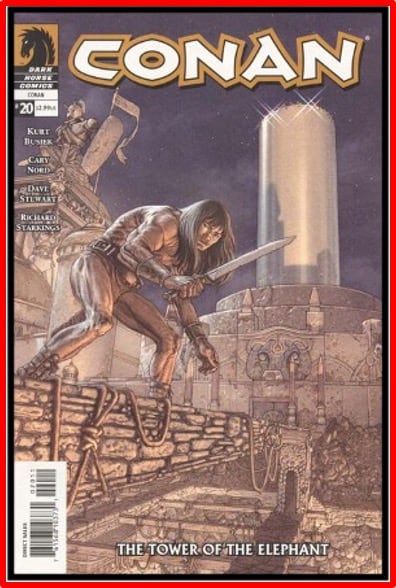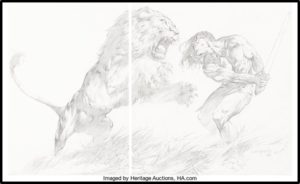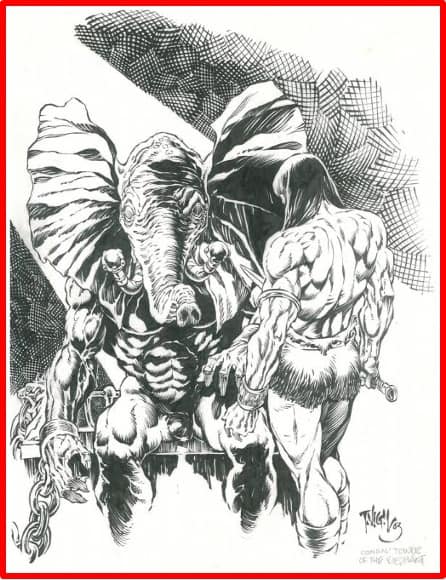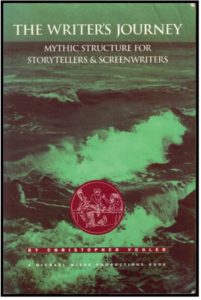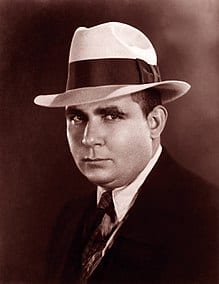This blog post explores the Hero’s Journey model of narrative. It is the eighth in a series of story structure posts analysing Robert E Howard’s celebrated story, ‘The Tower of the Elephant’, which is summarised here. You can read the story itself here. The previous posts deal with the following models or processes:
The Hero’s Journey Model
After analysing hundreds of myths, Joseph Campbell in his book The Hero with a Thousand Faces came up with what he called the monomyth, the basic structure of all hero stories. This structure was popularised through George Lucas’s use of it in the first Star Wars film, and Hollywood uses it almost exclusively in its films, especially blockbusters.
As demonstrated by Christopher Vogler in his book The Writer’s Journey, the structure is also applicable to written stories. Below, I will analyse ‘The Tower of the Elephant’ using the Hero’s Journey, as the structure has come to be called. I will also look at archetypes Vogler has pointed out usually occur in the construction of such ‘hero’ stories.
Vogler’s version of the Hero’s Journey comprises twelve stages (a simplification of Campbell’s seventeen stages), though not all stages are present all the time and their order may vary:
- The Ordinary World
- Call to Adventure
- Refusal of the Call
- Meeting with the Mentor
- Crossing the First Threshold
- Tests, Allies and Enemies
- Approach to the Inmost Cave
- The Ordeal
- The Reward
- The Road back
- Resurrection
- Return with the Elixir
Act 1
As shown in the above diagram, the first four stages represent Separation, the equivalence of Campbell’s Departure.
1. The Ordinary World
Conan is living in the Maul in Zamora and happens to be drinking (one presumes) in one of its taverns. The first part of the story describes the Maul, the Tavern, the characters carousing within it, and the monologue of one character, the Kothian slave trader.
2. Call to Adventure
The Kothian talks about the secret in the Elephant’s Tower, and this piques Conan’s interest. After more explanation from the trader, Conan announces he will steal the gem. He is chastised and belittled by the Kothian: ‘He would steal the jewel of Yara!’
3. Refusal of the Call
As the narration makes clear, Conan may have walked away from the trader with only his pride damaged: ‘He was bewildered and chagrined and doubtless would have slunk away, abashed’, but the Kothian’s next words goad him further. When the slave trader makes the mistake of physically pushing the Cimmerian, the game, as they say, is on. Conan kills the trader and goes on his quest.
Yet, after Conan reaches the outer wall of the tower’s grounds, he considers turning away from the mission, another instance of refusal: ‘But he hesitated at the thought of the strange perils which were said to wait within’. However, after hearing ‘the clink of steel’ of a guard on the other side of the wall, but not hearing the guard return, ‘curiosity overcame him’ and he swung himself to the top of the wall.
4. Meeting with the Mentor
The only mentor figure that Conan meets is Taurus, though he turns out to be a turncoat when they reach the top of the tower and a treasure room is before them. One could argue Taurus isn’t much of a mentor before this change of role, in that he doesn’t seem to teach Conan anything about the world they are entering and travelling through. He also seems to act more as a helper or an ally (and then an enemy), which would mean he belongs to a later stage.
However, I would argue that Taurus does teach, through example, the need for preparedness, as with his months-long scouting of the target, and the bringing of the poison and the knotted rope. He also reinforces Conan’s self-belief in his courage: ‘I had thought only myself had the courage to attempt that poaching [of the Elephant’s Heart]’.
One might also argue that Yag-kosha, also known as Yogah of Yag, is a mentor, in that the being helps Conan discover an unknown part of himself: pity and compassion.
Act 2
Campbell defines the second act as Initiation, though Vogler has split this into two sub-acts: Descent and Initiation, which have three and two stages respectively.
5. Crossing the First Threshold (2A)
This is usually the moment the hero crosses from the Ordinary World into the Special World (see the diagram). Conan’s ordinary world, for the purposes of the story, is the tavern in the Maul. The moment he leaves the tavern, or more correctly, the area of the city that contains his usual haunts, and enters the precinct of the temples, is the moment he crosses the threshold into the Special World, the place where he will be tested as a hero.
The fact that this happens before he meets his mentor is of little concern, as the order of these early elements of the Hero’s Journey can vary. Although the Special World provides Conan with the means to become a hero, we already have seen glimpses in the ordinary world of his abilities, for example, his martial prowess in being able to kill the Kothian slave trader while the tavern is in darkness.
6. The Road of Trials: Tests, Allies and Enemies (2A)
As discussed above, Taurus is an ally as well as a mentor figure. One can’t consider Yag-kosha an ally because the idol is the goal of the journey. That cosmic being may help Conan defeat Yara, but this was not for Conan’s benefit but its own. In a sense, Conan becomes an ally of Yag-kosha in its journey of freedom and revenge.
As for the other two elements of this stage, one can distinguish between Tests and Enemies by saying that Enemies are living beings, while Tests are inanimate things or processes. So, the guard in the outer garden, the lions, and the guards inside the tower (which Conan in the end doesn’t have to deal with) are all Enemies. One could also claim that Taurus becomes an Enemy when he tries to prevent Conan from gaining his share of the treasure.
As for Tests, these would consist of the climbing of the two walls and of the tower itself, which are mundane trials compared to those of the Enemies.
7. Approach to the Inmost Cave (2A)
In this case, the inmost cave is the ‘glittering chamber’ atop the tower, the furthest point away from the Ordinary World. Here, Conan must face the betrayal of Taurus and try to figure out what killed the thief. When he doesn’t untangle this mystery, ‘Poison darts? thought Conan—but in that case the missiles would be still in the wounds’, he has no choice but to enter the room, cautiously. He notes the treasures it contains and the strange glyph in the middle of the ceiling:
In the very centre of the ceiling he idly noted a curious design—a black eight-sided pattern, in the centre of which four gems glittered with a red flame unlike the white blaze of the other jewels.
This glyph hides in some way the perch of the black spider, ‘as large as a pig’. It most likely is also part of the magic that creates and controls the monster, though Conan, because of his inexperience with magic at this stage in his saga, does not realise this.
8. The Ordeal (2B)
This is Conan’s battle with the spider, his desperate leaps and dodges of the spider’s fangs and web, and the recognition that his strength and speed—his prized barbarian attributes—are failing. After a long battle, he can’t avoid the web anymore and is captured. Exhausted, he is facing death as the spider moves towards him. He is desperate: ‘Stung to frenzy, Conan caught up a jewel chest and hurled it with all his strength’. The spider is killed. Conan survives.
One may criticise Conan’s desperate act as the usual cliché of pulp fiction stories: the last moment success, when all else is failing, through strength of will or muscle, a type of deus ex machina. However, throughout the story Conan is contrasted with civilised men and for him to be able to summon up the remnants of his strength and use it to defeat his foe is not much of a stretch. This is especially so when one remembers all those accounts of people being able to draw upon physical and mental reserves they never knew they had when in life-or-death situations, as in car accidents, etc.
9. The Reward (2B)
The reward for killing the spider is the chance to win the Elephant’s Heart. Conan moves downstairs to the next room and discovers more treasure and a strange statue in the shape of a deformed man with the head of a creature that is like an elephant. It is in this room that Conan faces something unexpected: the statue is a living being who asks for his help.
Conan must decide whether to continue his quest for treasure or help Yag-kosha. He decides to help. He decides, unconsciously, to give up his selfish thievery and become more compassionate, more human. A part of him dies, or at least is reduced, so that another part of him can grow.
Yet, the irony is that he must kill Yag-kosha to help that strange being. He is killing the presence of Yag-kosha in this plane of existence so it can reclaim its life in its normal plane of existence and become once more Yogah of Yag. (One could almost say Yag-kosha has been journeying in his own Special World, though not by choice, and Conan is returning it to its Ordinary World, the world of Yag.)
Act 3
Both Campbell and Vogler call the last act Return.
10. The Road Back
After carving out the heart of Yag-kosha and pouring its blood onto the heart gem, Conan carries the jewel to Yara’s room. There is a suggestion that Conan is under a trance during this period—‘it did not occur to him to ignore the instructions given him’—but it seems to me that he is doing something he is unaccustomed to doing (not functioning as a barbarian) and so is acclimatising to this wider sense of himself.
11. Resurrection
Conan enters Yara’s room, speaks the words Yag-kosha instructed him to speak, and places the gem on the table before the high priest. Conan watches the wizard try to evade his fate, watches as Yara is swallowed by the gem and hunted down by Yogah of Yag. When the gem blazes with the light of Yogah’s revenge-‘the great jewel vanished in a rainbow burst if iridescent gleams’-Conan is released. He makes his way down the stairs, past the dead guards, which were presumably killed by Yogah’s magic (as promised), and leaves the tower.
The sense of his being released from a spell, ‘he started like a man waking from a dream’, is his moment of resurrection, for he really is being released into a new version of himself, one who feels for others instead of only for himself. And of course, this episode is also the rebirth of Yag-kosha as Yogah of Yag.
12. Return with the Elixir
The ending of the story is quite fast, with Conan exiting the tower and the edifice, because it had been built by Yag-kosha ‘in a single night’, crashing ‘into shining shards’. The only Elixir Conan returns with is his new-found emotional connection, his sense of compassion, which presumably will help him in further adventures. He has gained some emotional experience, as opposed to martial, financial, political, or sexual experience. This gain is not articulated in the story, only suggested.
Archetypes
Vogler has also articulated the number of Jungian archetypes that are attached to the Hero’s Journey:
- Hero: Conan, of course. He is the instigator of the action in the story and the character who learns something about himself and his universe as he goes about trying to achieve his goal.
- Mentor: Taurus, obviously, and Yag-kosha, for Conan’s emotional revelation.
- Threshold Guardians: The guard in the outer garden, who is despatched by Taurus. The lions in the inner garden, also despatched by Taurus. The lion not killed by Taurus, which Conan kills. The giant black spider, which kills Taurus and is killed in turn by Conan.
- Trickster: Is usually a sidekick. There isn’t one in this story, unless we consider that, for a brief time, Conan is Taurus’s sidekick.
- Shape-shifter: Taurus, who turns from being a mentor and ally to a thief who tries to cut Conan out of his share of the ‘loot’ (so much for ‘honour amongst thieves’).
- Shadow: This is a hard one. The Shadow is the villain, someone who tests the Hero’s true abilities and worthiness, someone who forces the Hero to dig deep and rise to the challenge. Yara in one sense is the villain of the story, the person who owns and protects the Elephant’s Heart, who has imprisoned Yag-kosha, and who ruthlessly rules over Zamora. Yet, Conan does not face off with Yara. It is Yogah of Yag who deals with Yara, after Conan’s help. If we consider the Shadow as a symbol of a person’s repressed negative fears, views and desires, then maybe the Kothian slave trader and also ‘the prince of thieves’, Taurus, are reminders of the paths Conan could travel if he gave into such shadow qualities as greed and pride.
Summation
Robert E Howard’s ‘‘The Tower of the Elephant’ follows Campbell’s monomyth quite closely. This wouldn’t be a deliberate decision, unlike the example of George Lucas and other Hollywood writers and directors, because Howard wrote the story in 1993, many years before Campbell published The Hero with a Thousand Faces (1949). Still, Howard’s own reading of myths, fairy tales and history, as well as successful adventure stories (for example, those of Edgar Rice Burroughs and H Rider Haggard), likely equipped him unconsciously with a sense of a common structure for ‘hero’ stories.
I hope you enjoyed this exploration and affirmation of Campbell’s monomyth as a model for one type of story, that of heroes. Of course, the monomyth may not be as relevant for other types of stories, and I hope to visit appropriate models in future instalments.
I welcome any comments or questions about this analysis or any others in the series. Meanwhile, be safe, well and inspired!
Hwyl am y tro (Bye for now)
Earl
______________________________________________________


